Related Research Articles
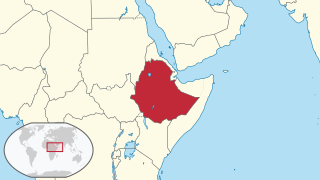
Year 1542 (MDXLII) was a common year starting on Sunday of the Julian calendar.

Vasco da Gama, 1st Count of Vidigueira, was a Portuguese explorer and the first European to reach India by sea.
Jerónimo Lobo was a Portuguese Jesuit missionary. He took part in the unsuccessful efforts to convert Ethiopia from the native Ethiopian church to Roman Catholicism until the expulsion of the Jesuits in 1643. Afterwards he wrote an account of his time in Ethiopia, Itinerário, which is an important source for the history and culture of that country.

Ahmad ibn Ibrahim al-Ghazi was the Imam of the Adal Sultanate from 1527 to 1543. Commonly named Ahmed Gragn in Amharic and Gurey in Somali, both meaning the left-handed, he led the invasion and conquest of Abyssinia from the Sultanate of Adal during the Ethiopian-Adal War. He is often referred to as the "King of Zeila" in medieval texts.
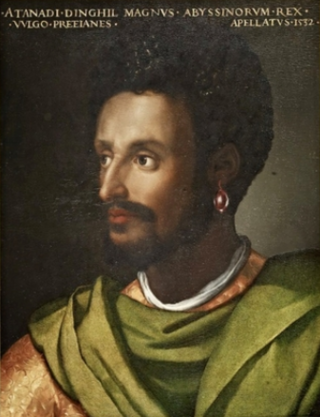
Dawit II, also known by the macaronic name Wanag Segad, better known by his birth name Lebna Dengel, was Emperor of Ethiopia from 1508 to 1540, whose political center and palace was in Shewa.

Menas or Minas, throne name Admas Sagad I, was Emperor of Ethiopia from 1559 until his death in 1563, and a member of the Solomonic dynasty. He was a brother of Gelawdewos and the son of Emperor Dawit II.

The Battle of Wayna Daga was a large-scale battle between the Ethiopian forces and the Portuguese Empire and the forces of the Adal Sultanate and the Ottoman Empire in the east of Lake Tana in Ethiopia on 21 February 1543. The available sources give different dates for the battle. Led by the Emperor Galawdewos, the combined army of Ethiopian and Portuguese troops defeated the Adal-Ottoman army led by Imam Ahmad ibn Ibrahim al-Ghazi. Imam Ahmad was killed in the battle and his followers were utterly routed.
The Battle of Wofla was fought on August 28, 1542 near Lake Ashenge in Wofla (Ofla) between the Portuguese under Cristóvão da Gama and the forces of Imam Ahmad ibn Ibrahim al-Ghazi. Reinforced with a superiority not only in numbers but in firearms, Imam Ahmad was victorious and forced the Portuguese, along with Queen Seble Wongel and her retinue, to flee their fortified encampment and leave their weapons behind.
The Battle of Baçente was fought on February 2, 1542, when a Portuguese army under Cristóvão da Gama took a hillfort held by Adalite forces in northern Ethiopia. The Portuguese suffered minimal casualties, while the defenders were reportedly all killed.
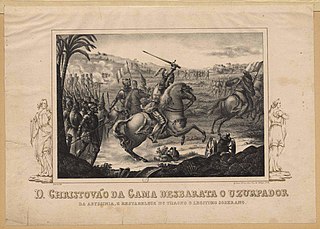
The Battle of Jarte was fought from 4 to 16 April 1542 between the forces of Ahmad ibn Ibrahim al-Ghazi and the Ethiopian Empire assisted by a Portuguese expeditionary force led by Cristóvão da Gama. The Abyssinians and Portuguese were victorious, with Ahmad Gurey wounded by the outnumbered Christian force, and the Adalites forced to retreat.
Yeshaq was the Bahr Negus during the mid to late 16th century. A subordinate of Ethiopian Emperor Dawit II, he was noted for supporting Gelawdewos during the Ethiopian-Adal war, and rebelling against his successors.
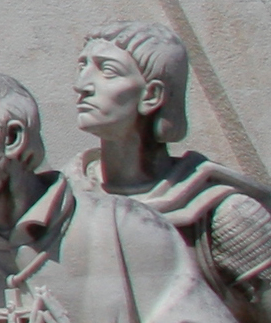
Cristóvão da Gama, anglicised as Christopher da Gama, was a Portuguese military commander who led a Portuguese army of 400 musketeers to assist Ethiopia that faced Islamic Jihad from the Adal Sultanate led by Imam Ahmad ibn Ibrahim al-Ghazi.
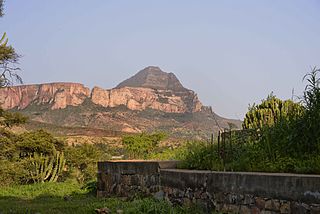
Enticho is one of woredas in the Tigray Region of Ethiopia. Part of the Maekelay Zone, Enticho is bordered on the south by Werie Lehe, on the southwest by Adwa, on the west by Mereb Lehe, on the north by Eritrea, and on the east by the Misraqawi (Eastern) Zone. The administrative center of this woreda is Enticho; other towns in Enticho include Edaga Arbi, and Gerhusernay. Ancient monastery of Debre Damo is also located in Enticho.

Debarwa is a market town in central Eritrea. It is situated about 25 kilometers south of the capital Asmara, and has a population of about 25,000 inhabitants. It is the capital of the Debarwa district (Tsilima) in the Debub ("Southern") administrative region.

The Ethiopian–Adal War or Abyssinian–Adal War, also known in Arabic as the "Futuḥ al-Ḥabash", was a military conflict between the Christian Ethiopian Empire and the Muslim Adal Sultanate from 1529 to 1543. The Christian Ethiopian troops consisted of the Amhara, Tigrayans, Tigrinya and Agaw people, and at the closing of the war, supported by a few hundred Portuguese musketmen. Whereas Adal forces were mainly composed of Harla, Somali, Afar, as well as Arab and Turkish gunmen. Both sides at times would see the Maya mercenaries join their ranks.

The Ottoman-Portuguese conflicts were a period of conflict during the Ottoman–Portuguese confrontations and series of armed military encounters between the Portuguese Empire and the Ottoman Empire along with regional allies in and along the Indian Ocean, Persian Gulf, and Red Sea.
The 4th Portuguese India Armada was a Portuguese fleet that sailed from Lisbon in February, 1502. Assembled on the order of King Manuel I of Portugal and placed under the command of D. Vasco da Gama, it was the fourth of some thirteen Portuguese India Armadas, was Gama's second trip to India, and was designed as a punitive expedition targeting Calicut to avenge the numerous defeats of the 2nd Armada two years earlier.
The Sixth India Armada was assembled in 1504 on the order of King Manuel I of Portugal and placed under the command of Lopo Soares de Albergaria.
Seble Wongel was Empress of Ethiopia through her marriage to Lebna Dengel. She is well-known as a key political and military figure during the Ethiopian–Adal War, as well as the reigns of her sons and grandson.

Somali–Portuguese conflicts refers to the armed engagements between Portuguese forces and Somali forces, namely those of the Adal Sultanate and the cities of Barawa and Mogadishu in the 16th century.
References
- ↑ R.S. Whiteway, editor and translator, The Portuguese Expedition to Abyssinia in 1441-1543, 1902. (Nendeln, Liechtenstein: Kraus Reprint, 1967), p. 56
- ↑ Whiteway, Portuguese Expedition, pp. lvii-lxii
- ↑ Beckingham, "A Note on the topography of Ahmad Gragn's campaigns in 1542", Journal of Semitic Studies, 4 (1959), pp. 362-373